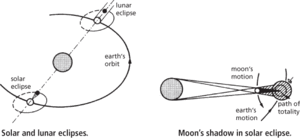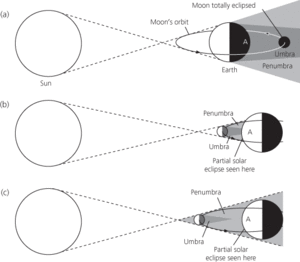The total (total eclipse) or partial (partial eclipse) obscuring of light from a celestial body as it passes behind or through the shadow of another body. A lunar eclipse occurs when the sun, earth, and moon are in a straight line and the shadow of the earth falls on the moon. A solar eclipse occurs when the shadow of the moon falls on the earth.

Eclipse.
The entry of one celestial body into the shadow of another; strictly speaking, an eclipse of the Sun is an occultation, not an eclipse. In any one year, the maximum total of solar and lunar eclipses visible from Earth is seven. The minimum number is two, both of which must be solar. Eclipses frequently come in pairs, with a lunar eclipse preceded or followed within a fortnight or so by a solar eclipse at the opposite node of the Moon’s orbit. As seen from any one place, lunar eclipses are twice as common as solar eclipses.
Solar eclipses occur when the new Moon lies close to the node of its orbit and at the same longitude as the Sun. The Moon obscures at least part of the Sun’s disk as seen from a comparatively limited ground track where the cone of shadow cast by the Moon falls on the Earth’s surface. Along the centre of this track a total eclipse may be seen; eclipses occurring around lunar apogee may be annular eclipses. A partial eclipse is seen either side of the central path of totality or annularity, which sweeps eastwards at around 3200 km/h. The maximum diameter of the Moon’s umbral cone at the Earth is 270 km, but the actual width of the shadow path on the Earth’s surface can become much greater than this at high latitudes, where the umbral cone strikes the surface at an oblique angle. At a total eclipse, the Moon moves across the Sun’s disk for an hour or so, until the Sun is completely covered and its corona becomes visible. By coincidence, the Sun and Moon have much the same apparent angular diameter (about ½°). Total solar eclipses are rare at any one place on the Earth, so astronomers usually have to travel long distances to see them. A solar eclipse can last up to 3 hours from first contact to fourth contact; totality has a theoretical maximum duration of 7 m 32 s, but is usually much shorter. A lunar eclipse is visible from Earth wherever the Moon is above the observer’s horizon, and occurs as the full Moon passes through the Earth’s shadow. A total lunar eclipse occurs when the Moon passes through the dark central umbra of the Earth’s shadow. Partial lunar eclipses are also seen, as are penumbral eclipses, which are often barely noticeable. The Earth’s shadow is much broader than the Moon itself, so that lunar eclipses may last for up to 4 hours from first contact to fourth contact; totality lasts up to 1 h 47 m.
Planetary satellites are also eclipsed by the shadows of their primaries; those of the Galilean satellites of Jupiter are readily observable.
eclipse:

(a) In a total lunar eclipse the Moon, viewed from point A, is faintly illuminated by sunlight refracted through the Earth’s atmosphere. (b) An observer at A sees the Sun’s disk completely obscured by the Moon in a total solar eclipse, but the solar corona becomes visible. (c) In an annular eclipse of the Sun, an observer at A sees the Moon framed by the outline of the Sun. In (b) and (c), observers within the Sun’s penumbra see a partial solar eclipse.
http://eclipse.gsfc.nasa.gov/eclipse.html NASA eclipse website.
The passage of one astronomical body through the shadow of another. The term is usually used for solar and lunar eclipses. A solar eclipse occurs when the Moon is between the Earth and the Sun (which can happen only at new Moon), the Moon blocking the Sun's rays and casting a shadow on the Earth's surface. A lunar eclipse occurs when the Earth is between the Moon and the Sun (which can happen only at full Moon), the Earth blocking the Sun's rays and casting a shadow on the Moon's surface.
During a total solar eclipse the Moon appears to cover the Sun's disc completely and day turns into night. This is known as the umbra. A total solar eclipse can last up to 7.5 minutes, and the Sun's corona can be seen. Between two and five solar eclipses occur each year but each is visible only from a specific area. During a partial solar eclipse sunlight reaches the Earth from around the edge of the Moon. This is known as the pre-umbra. Lunar eclipses can also be partial or total. Total lunar eclipses last for up to 100 minutes; the maximum number each year is three.
An eclipse can refer to other bodies; for example, to an eclipse of one of Jupiter's satellites by Jupiter itself. An eclipse of a star by a body in the Solar System is also called an occultation.

The two types of eclipse: lunar and solar. A lunar eclipse occurs when the Moon passes through the shadow of the Earth. A solar eclipse occurs when the Moon passes between the Sun and the Earth, blocking out the Sun's light. During a total solar eclipse, when the Moon completely covers the Sun, the Moon's shadow sweeps across the Earth's surface from west to east at a speed of 3 200 kph.
Credit: NASA
https://eclipse.gsfc.nasa.gov/eclipse.html Excellent site covering past and upcoming solar and lunar eclipses, with valuable information on safety and descriptions of the events.
https://www.nasa.gov/eclipse Another NASA site containing information on solar and lunar eclipses, eye safety, and more.
The partial or complete obscuration of one heavenly body by another, as perceived by an observer on one of the bodies. The proper description of an eclipse also refers to the period of time involved.
- wetland
- wet mass
- wet melt
- wetness index
- wet process
- wet scrubbing
- wet steam
- wetted perimeter
- wetting
- wetting agent
- wet-trash stowage compartment
- wet workshop
- Weygand, Maxime (1867–1965)
- Weyl, Hermann
- Weyl, Hermann (1885–1955)
- Wezen
- wff
- W-fold
- W grammar
- Whaingaroan
- whaleback
- whalebone
- whales
- whaling
- what you get is what you never thought you had